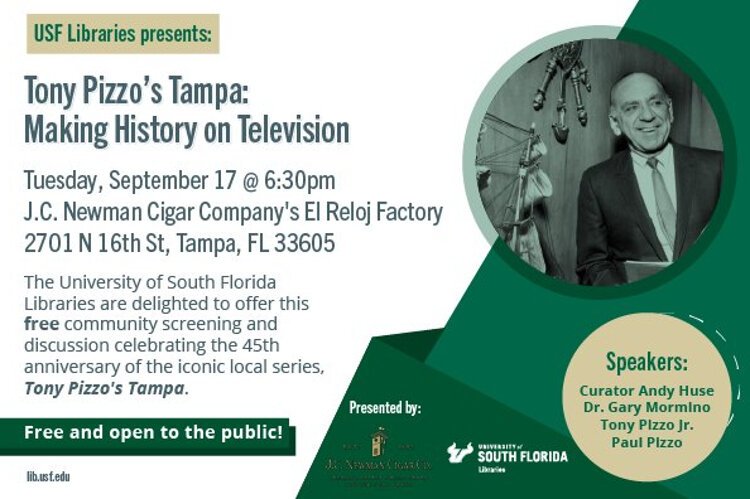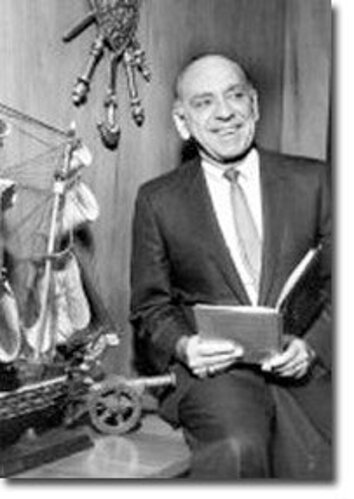Step back in time with “Tony Pizzo’s Tampa”
Tony Pizzo was a Tampa history buff who became Tampa's history teacher. Thirty years after his death, USF has digitized his old TV show, "Tony Pizzo's Tampa" and celebrates his legacy with an upcoming event in Ybor
Tony Pizzo was a Tampa history buff who became Tampa’s history teacher.
The businessman’s hobby turned into two books and a 10-part series on University of South Florida public television called “Tony Pizzo’s Tampa.’’
Born in Ybor City to second-generation Italian immigrants, he died in 1994 at age 81. Pizzo grew up in the bustling district populated by Cuban, Spanish and Italian immigrants who came to Ybor to work in the thriving cigar-making industry. In his books and lectures, he captured the atmosphere, the sounds of horse carts on brick streets and vendors hawking their goods, the smell of cigars and Cuban coffee.
On Sept. 17, Pizzo will be the focus of discussion at an event celebrating the 45th anniversary of his show’s debut and the fact that USF library has recently finished digitizing the entire series so anyone can watch the shows online. The event is free and open to the public. It begins at 6:30 p.m. at the J.C. Newman Cigar Company’s El Reloj, 2701 N. 16th St., Ybor City.
“It’s a really neat artifact of Tampa’s history,’’ says Andrew Huse, USF Special Collections librarian and author of three books on Tampa history.
He notes that Pizzo “went from documenting Tampa’s history to becoming Tampa’s history.’’ To his point, a bronze statue capturing Pizzo in mid-lecture stands in Ybor Centennial Park at Eighth Avenue near Angel Oliva Senior Street.
Huse and three others will lead the discussion: Dr. Gary Mormino, history professor and a Pizzo co-author who co-founded the Florida Studies graduate program at USF; and Pizzo’s two sons, Dr. Anthony Pizzo Jr. and Paul Pizzo.
“We’re all going to discuss a little bit about the background and then there’s going to be a little bit of screening, too,’’ Huse says. “So it should be a lot of fun.’’
Mormino, who has written six books on Florida history, says Pizzo was one of the first people he met when he arrived at USF in 1977.
“What a remarkable character,’’ he says.
Pizzo attended the University of Florida for two years but graduated from Stetson University in Deland. He planned to be a lawyer but decided to go into business instead. He eventually became vice president of sales for the House of Midulla, Inc. liquor and wine company and president of Fruit Wines of Florida, Inc., a Midulla company.
In the meantime, he researched the history for some 80 historical markers in Ybor and Tampa. He also wrote “Tampa Town, 1824 to 1886, Cracker Town with a Latin Accent’’ (1968) and, with Mormino, “Tampa – The Treasure City’’ (1983). He was a key founder of the Tampa Historical Society and served as Chairman of the Hillsborough County Historical Commission from 1968 to 1980.
“He also was one of the first Latins to really become friends with the Anglo establishment. He had no enemies,’’ Mormino says.
A charming, courtly man with a keen sense of humor, Pizzo was beloved.
“Who else could get his name on the title of the show?’’ says Mormino, who was interviewed by Pizzo in one of the shows.
“I did watch them every week and I was honored to have a very small role in one of them,” he says. “But I really wasn’t considered an expert. I’d only been here three years at that time. But what a tribute to him. Not many people could pull that off.’’
The series starts with the original inhabitants of Florida, the Timacuan Indians in the north and the Calusa in the Tampa Bay area and south. It proceeds through the Seminole era and the establishment of the Fort Brooke army outpost in 1824, the arrival of the Latin immigrants and their impact on Tampa’s culture, the influx of new residents after World War II and the growth of Tampa through the 1970s.
Mormino says one theme of history that he loves is sounds we will never hear again. Pizzo was interested in that too. Mormino imagines Pizzo as a child on the balcony of his home, near the family grocery store – which became Castellano & Pizzo – taking in the sights and sounds of the bustling streets of Ybor.
“He’d talk about the fruit and vegetable vendors, each one selling something different. The Mondongo man, who was selling tripe sandwiches, which were very popular; the deviled crab man; the bolita man coming,’’ Mormino recalls.
“It’s like the world was coming outside his balcony there, and he was a sponge,’’ he adds.
To view the digitized episodes online, go to Tony Pizzo’s Tampa
















